#LapsangSouchong
Explore tagged Tumblr posts
Text
Rose-scented Chinese date tea for relieving heat in summer.
#rosetea#morimatea#tea#teatime#flower tea#black tea#lapsangsouchong#teaandseasons#summertime#relaxmoment#cozy and comfy#teastyle#summertea#teaforlife
4 notes
·
View notes
Text
Strongest Black Tea: Bold Flavors, Big Energy

Introduction
Black tea, with its robust character and invigorating kick, is a beloved staple for tea enthusiasts worldwide. For those seeking an intense, energizing experience, the strongest black tea varieties deliver unparalleled depth and caffeine content. These teas, often characterized by bold, malty, or smoky profiles, are perfect for morning wake-ups or moments requiring focus. From the brisk Assam of India to the smoky Lapsang Souchong of China, the strongest black teas offer a powerful sip that captivates the senses. In this blog, we’ll explore what makes a black tea “strong,” highlight top varieties, share brewing tips, and discuss their cultural significance, inviting you to embrace the bold world of black tea.
What Makes a Black Tea “Strong”?
The strength of black tea stems from several factors: caffeine content, flavor intensity, and leaf grade. Black teas are fully oxidized leaves of the Camellia sinensis plant, which enhances their robust taste and higher caffeine levels (typically 40-70 mg per cup) compared to green or white teas. Smaller, broken leaves or fannings, common in strong varieties like Assam or English Breakfast, release flavor and caffeine quickly, creating a potent brew. Bold flavor profiles—malty, smoky, or astringent—also contribute to perceived strength. The strongest black teas are often grown in regions with rich soils, like Assam or Sri Lanka, where terroir amplifies their vigor. This combination of factors makes these teas ideal for those craving a full-bodied, energizing cup.
Top Varieties of the Strongest Black Teas
The strongest black teas are celebrated for their intensity and versatility, each offering a unique profile shaped by origin and processing. Here are some standout varieties:
Assam: Grown in India’s Assam region, this tea is known for its malty, brisk flavor and high caffeine content, making it a breakfast favorite.
English Breakfast: A blend of Assam, Ceylon, and Kenyan teas, it delivers a robust, full-bodied taste with a balanced astringency.
Lapsang Souchong: A Chinese tea smoked over pinewood, offering a bold, smoky flavor that’s both intense and distinctive.
Ceylon: From Sri Lanka’s highlands, this tea is bright, citrusy, and strong, especially in broken leaf grades like Orange Pekoe.
Kenyan Black: Known for its rich, dark liquor and assertive taste, it’s a key component in many strong blends.
Explore Backyard Brew’s selection of black tea leaves, where their organic Assam and Lapsang Souchong, ethically sourced from premier regions, deliver the boldest flavors for your morning brew. Visit Backyard Brew to discover these premium teas. These varieties are perfect for those seeking a powerful, flavorful experience that stands up to milk, sugar, or solo sipping.
Cultural Significance of Strong Black Teas
Strong black teas have deep cultural roots across the globe. In India, Assam is a cornerstone of chai culture, boiled with spices and milk for a hearty, communal drink. In Britain, English Breakfast tea anchors the afternoon tea tradition, symbolizing hospitality and refinement. Lapsang Souchong, with its ancient Chinese origins, reflects the ingenuity of smoking tea for preservation, a technique that adds its iconic intensity. In East Africa, Kenyan black tea fuels daily life, often brewed strong and sweet. These teas are more than beverages; they’re woven into rituals that foster connection and resilience, reflecting the strength of the communities that cherish them. Their global appeal lies in their ability to energize and unite, making every cup a cultural experience.
Health Benefits of Strong Black Teas
The strongest black teas offer more than bold flavor—they’re packed with health benefits that enhance well-being:
Energy Boost: High caffeine content provides a sustained lift, ideal for mornings or focused tasks, balanced by L-theanine for calm alertness.
Heart Health: Flavonoids may reduce LDL cholesterol and support cardiovascular function, promoting heart wellness.
Antioxidant Support: Polyphenols combat oxidative stress, reducing inflammation and supporting cellular health.
Digestive Aid: Black tea’s tannins can soothe the stomach, aiding digestion after meals.
Mental Clarity: The caffeine-L-theanine synergy enhances focus and cognitive performance without jitters.
Moderate consumption (2-3 cups daily) maximizes these benefits while minimizing caffeine-related side effects, making strong black teas a flavorful, health-conscious choice.
Brewing the Perfect Strong Black Tea
To unlock the full intensity of the strongest black teas, precise brewing is key. Follow these steps:
Water Temperature: Use boiling water (212°F or 100°C) to extract robust flavors and caffeine.
Tea-to-Water Ratio: Use 1-1.5 teaspoons of loose-leaf tea per 8 ounces of water for a potent brew.
Steeping Time: Steep for 3-5 minutes. Longer steeping enhances strength but may increase bitterness, so adjust to taste.
Equipment: A ceramic teapot or basket infuser allows leaves to expand, maximizing flavor release.
Use filtered water for a clean taste, and store tea in an airtight, opaque container away from light and moisture to preserve freshness. Add milk, sugar, or lemon to temper astringency, though many strong teas shine when brewed pure to highlight their bold character.
Pairing Strong Black Teas with Food
The intense flavors of strong black teas pair beautifully with a variety of foods, enhancing both taste and dining occasions:
Breakfast: Assam or English Breakfast complements eggs, bacon, or buttered toast, balancing savory richness.
Desserts: Lapsang Souchong’s smokiness pairs with dark chocolate or caramel pastries, amplifying bold notes.
Savory Dishes: Ceylon matches spicy curries or grilled meats, refreshing the palate with its brightness.
Cheese: Kenyan black tea harmonizes with aged cheeses like cheddar, echoing its robust depth.
For a tea tasting, serve strong black teas with small bites like scones or smoked salmon, creating a refined experience that showcases their intensity.
Conclusion
The strongest black teas are a celebration of bold flavors, cultural heritage, and invigorating energy, offering a powerful sip for any occasion. From the malty punch of Assam to the smoky allure of Lapsang Souchong, these teas deliver depth and character that captivate tea lovers. By choosing high-quality leaves, brewing with precision, and pairing thoughtfully, you can elevate your tea ritual into a moment of strength and connection. Whether you’re powering through a busy morning or savoring a quiet afternoon, strong black teas provide a robust, flavorful experience. Embrace their intensity and make them a cornerstone of your tea journey, savoring the bold bliss in every cup.
FAQs
1. What makes a black tea the “strongest”?Strength comes from high caffeine content, bold flavors (malty or smoky), and smaller leaf grades that release flavor quickly, as seen in Assam or Lapsang Souchong.
2. How much caffeine is in the strongest black teas?They typically contain 40-70 mg of caffeine per cup, depending on the variety and brewing time, offering a significant energy boost.
3. Can I steep strong black teas multiple times?Unlike oolong or Pu-erh, black teas are usually steeped once, as their bold flavor is fully extracted in the first infusion.
4. How should I store strong black teas to keep them fresh?Store in an airtight, opaque container in a cool, dark place to protect against light, air, and moisture, preserving flavor for up to two years.
5. Why choose Backyard Brew for strong black teas?Backyard Brew offers organic, ethically sourced black teas like Assam and Lapsang Souchong, ensuring premium quality and bold flavors for an exceptional brew.
#BlackTea#StrongTea#TeaLovers#TeaTime#LooseLeafTea#AssamTea#LapsangSouchong#MorningBrew#BoldFlavors#TeaRitual#OrganicTea#TeaCulture#CaffeineBoost#TeaHealthBenefits#TeaPairing
0 notes
Text
Lapsang Souchong (Oolong Tea): Bold, Smoky, and Unforgettable

Tea enthusiasts often search for blends that offer more than the ordinary, something that challenges their taste buds and opens them up to new experiences. Lapsang Souchong, a variety of oolong tea, stands out as a bold choice for those who crave a distinctive and smoky tea experience. At Backyard Brew, we celebrate the uniqueness of Lapsang Souchong for its rich, complex flavors and its fascinating history.
What is Lapsang Souchong?
Lapsang Souchong is a traditional Chinese tea, originating from the Wuyi Mountains in the Fujian province of China. It is part of the oolong tea category, known for its partial oxidation that delivers a flavor profile between green and black teas. What truly sets Lapsang Souchong apart, however, is its unique smoking process.
The Smoking Process: A Key to Its Flavor
The bold, smoky flavor of Lapsang Souchong comes from the way it is processed. The tea leaves are withered over pine wood fires, a method that imparts a strong, distinctive aroma and taste. This smoking process results in a tea that is more robust and daring than many other varieties, making it a favorite among those who appreciate powerful and complex flavors.
Why You Should Try Lapsang Souchong
Lapsang Souchong is not for the faint of heart. It offers a taste profile that is smoky, bold, and rich, making it perfect for tea drinkers looking for something different. Here are some reasons why Lapsang Souchong is a must-try:
1. Unmatched Flavor Profile
The smoky flavor of Lapsang Souchong can be compared to a campfire in a cup. This intense taste is accompanied by subtle notes of pine and wood, making it ideal for those who enjoy deeper, earthy flavors. It's a tea that stands out from the crowd and is perfect for sipping slowly to savor its layers of taste.
2. Versatile Pairing
Lapsang Souchong is not only a great tea to enjoy on its own but also works well in culinary applications. Its bold flavor pairs excellently with hearty foods such as grilled meats, smoked dishes, and even strong cheeses. The tea's unique taste can complement and balance rich or spicy flavors, making it an excellent choice for pairing with food.
3. Health Benefits
Like other oolong teas, Lapsang Souchong offers numerous health benefits. It is rich in antioxidants, which can help combat free radicals and promote overall well-being. Additionally, its moderate caffeine content makes it an ideal choice for those who want a gentle energy boost without the intensity of black tea or coffee.
How to Brew Lapsang Souchong
To get the most out of your Lapsang Souchong, it’s essential to know how to brew it correctly:
Brewing Instructions:
Water Temperature: Use water at around 200°F (93°C). Water that is too hot can make the tea taste overly bitter, while water that is too cool won’t extract the full flavor.
Steeping Time: Steep the tea for 3-5 minutes. This will allow the bold, smoky flavors to infuse properly without becoming too overpowering.
Leaf Quantity: Use approximately 1 teaspoon of tea leaves per 8-ounce cup of water. This ratio ensures that the flavors are well-balanced.
Tips for a Better Experience:
Multiple Steepings: Lapsang Souchong can be steeped multiple times, with the flavor evolving and developing further with each infusion.
Experiment with Additions: Some people enjoy adding a touch of honey or milk to balance the tea’s smoky nature. Experiment to see what you prefer.
Unique Taste of Oolong Tea
Lapsang Souchong offers an unmatched sensory journey. Its distinct aroma, reminiscent of a pine forest, blends seamlessly with a deep, smoky flavor that is both captivating and soothing. Discover the unique taste of oolong tea with this bold and intriguing blend. For tea enthusiasts ready to expand their palate, Lapsang Souchong presents an opportunity to experience a truly exceptional flavor profile and enrich your tea-drinking moments.
Where to Find Lapsang Souchong
At Backyard Brew, we take pride in offering quality teas that are carefully sourced and crafted to deliver an exceptional experience. Our Lapsang Souchong (Oolong Tea) is no exception. Each batch is meticulously processed to maintain its characteristic smokiness and bold flavors, ensuring that you get the best in every sip.
FAQs About Lapsang Souchong
1. What does Lapsang Souchong taste like?
Lapsang Souchong has a bold, smoky taste that is complemented by subtle notes of pine and wood. The flavor is robust and earthy, making it a unique choice for adventurous tea drinkers.
2. How is Lapsang Souchong processed?
Lapsang Souchong is processed by withering tea leaves over pine wood fires, which infuses the leaves with a distinct smoky aroma and flavor.
3. Can Lapsang Souchong be enjoyed with food?
Yes, Lapsang Souchong pairs well with rich, hearty dishes such as grilled meats and smoked foods. It can also be enjoyed with strong cheeses or used in recipes that call for a smoky flavor.
4. What are the health benefits of Lapsang Souchong?
Lapsang Souchong, like other oolong teas, is rich in antioxidants that promote overall health. It may help reduce stress, improve heart health, and support metabolism.
5. Can Lapsang Souchong be re-steeped?
Yes, you can re-steep Lapsang Souchong multiple times. Each steeping will reveal new layers of flavor, providing a full tea-drinking experience.
Conclusion
Lapsang Souchong is more than just a tea; it’s a bold exploration of flavor that offers something truly special for tea enthusiasts. Its rich, smoky profile is perfect for those seeking a unique twist on traditional oolong teas. Whether you enjoy it by itself or pair it with food, Lapsang Souchong is sure to become a memorable part of your tea collection. Discover the unique taste of oolong tea and embrace the bold flavors that make Lapsang Souchong a must-try.
#LapsangSouchong#OolongTea#SmokyTea#BoldFlavors#TeaLovers#UniqueTeaExperience#BackyardBrew#TeaTime#ChineseTea#PineSmokedTea#TeaEnthusiasts#CraftedWithCare#TeaDrinking#TeaPairing#AntioxidantTea#BoldTaste#SpecialtyTea#TeaBrewing#HeritageTea#ExploreTea
0 notes
Text
It’s a perfect day in MI with the weather being over 40 F. Do you know what that means? As a Chef and Texan, I have to cook something outside over fire. Tonight’s selection will be some brisket burnt ends but what tea can stand up to it? ITeaworld has the answer.
Timing is everything and this tea review was perfect timing for it to be in the rotation to share with you. Their Lapsang Souchong brew shows amazing depth, deep smoky malt along with a big structure in the mouthfeel and body to stand up to smoked meats. It’s an amazing tea that is a great price per cup along with showcasing rich flavors.
Pop over to the ArtofthePair.com to check out this week’s review and my suggestions for pairing. This is one that you will want to check out and have on hand for the upcoming grilling months. For me, that’s all year round if I can dig out the smoker. 😊
WWW.ArtofthePair.com
#tea #tealife #tealover #tealifestyle #blacktea #foodies #foodiesofinstagram #chef #chefs #beverages #beverage #sommelier #teasommelier #texsom #smokedmeats #brisket #burntends #pizza #woodfiredpizza #lapsangsouchong #souchong
0 notes
Text
2022 Smoked Lapsang | White2tea

Trying to get through all the W2T samples I’ve yet to put here. I’m actually running out of tea at school! So if I run out I’ll probably place an order soon for some new stuff. Maybe Yeeon, LP, or something similar.
This is the smokiest smoked Lapsang I’ve had. The campfire-like smoke can be smelt strongly on the dry leaves and only gets stronger once hot water hits it. The entire room will smell like campfire and cigarettes once you start brewing this tea. Once again, it has those nicely rolled leaves that open up easy in my teapot. Definitely drank the rinse here. Liquor color is something I don’t normally see, and is pretty unique. The yellow color is slightly opaque and almost tinted. Like a lightly fogged gold. Surprisingly, flavor is pretty standard here. Tastes like high end smoked Lapsang, but doesn’t quite hit the quality I’d expect for the budget. It’s not an extremely pricey tea, but, as a Lapsang, I find myself wondering if the price to quality ratio has been maxed out. I ask the same question when I’m drinking a shou that is way over the $1 per gram margin. There are some teas that fit in that sweet spot, but I’m unsure about this one! Not to say it’s not a great tea, just that its flavor is nothing shocking. Tastes like smoked Lapsang, and it is smoked Lapsang. Aroma, liquor color, texture, leaf quality, etc are all the things keeping these leaves at a higher price.
★ ★ ☆ ☆ ☆
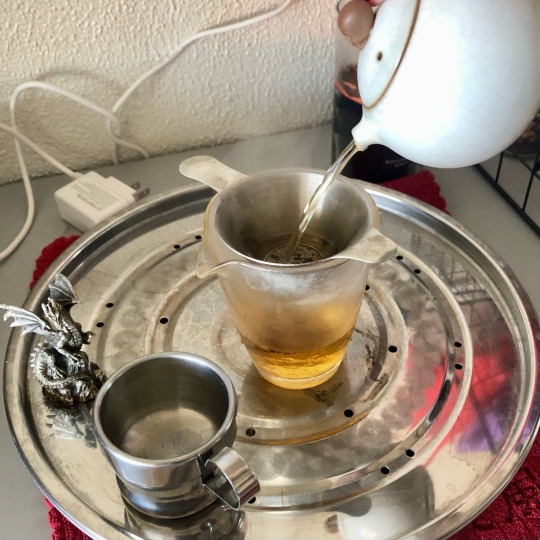
#gongfu#gongfucha#yixing#gongfu tea#teablr#steepster#puerh#tea#cha dao#tea blog#apoostrotea2#white2tea#Lapsang#lapsangsouchong
7 notes
·
View notes
Text



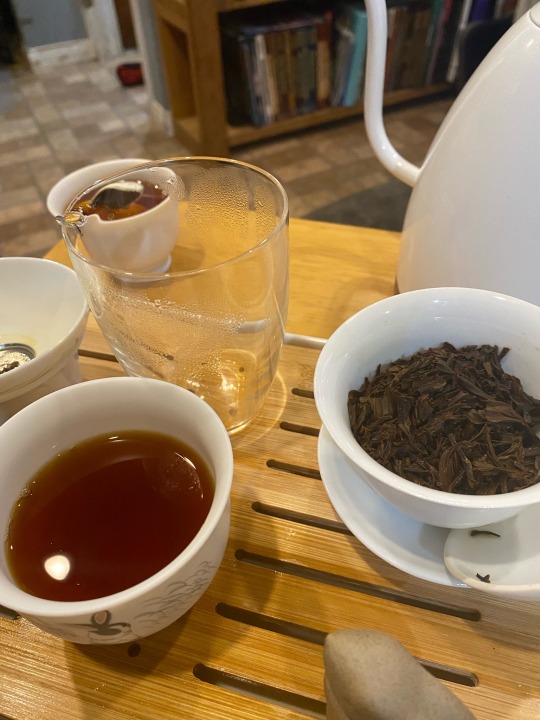
Lapsang Souchong Red Tea session.
🐯 Theadore the Tiger
🐰 Marilyn Bunroe
🐇 Jibi, the Golden Rabbit
#tea addict#tea set#session#gongfucha#tea pet#rabbit#tiger#bunny#gong fu#chinese tea#lapsangsouchong#Zhengshan xiaozhong#cha#meeshisdumb
4 notes
·
View notes
Text



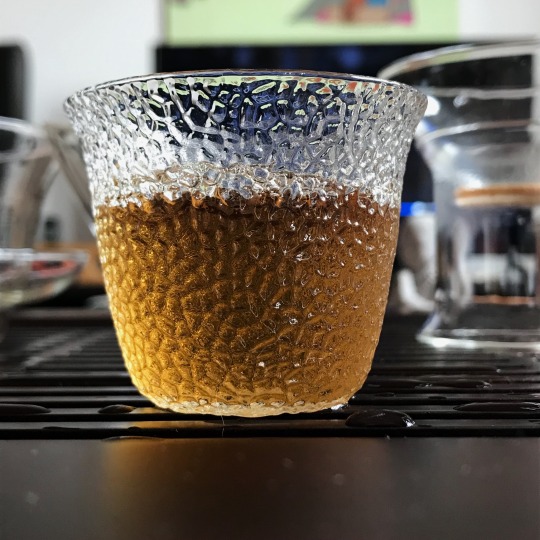
smoked tea is by far the most interesting thing that has happened to me in months. tastes a bit like pine resin? or maybe smoked wood
98 notes
·
View notes
Photo
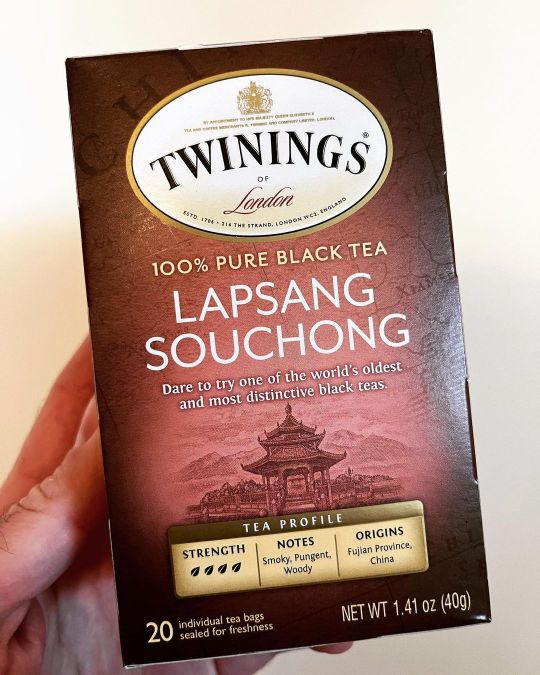
I will dare! #tea #lapsangsouchong #ridiculousmarketing (at Philadelphia, Pennsylvania) https://www.instagram.com/p/ClEhxMepQALYSX1j64r8zP_Hl4fhUdHxFG7IOA0/?igshid=NGJjMDIxMWI=
2 notes
·
View notes
Text
Tasting: Spiced Lapsang

The second Lapsang I ordered in my latest White2Tea haul. The biggest difference between this one and the Pine Sap Lapsang is that this one is NOT smoked. In fact, for those of you who may not know, not all Lapsang is smoked, however smoked is the best known and most common type of Lapsang, especially in the western market.
The natural spice of the tea was pretty apparent from the start. The dry leaf has aromas of cinnamon and nutmeg with additional notes of taro, dry charcoal and sour plum. The wet leaf released stronger spice notes similar to Chinese 5 spice. Heavy notes of sweet potato with a hit of floralness and soft fruity tones.

I found the first infusion to have a soft and subtle bitterness on the throat. The mouthfeel is clean with a maltiness that is not too overpowering. Heavy flavors of nutmeg and cinnamon, and more vegetal notes of raw spuds and spiced carrots. I also found it to have a very warming feeling in the chest after swallowing. The second infusion had much less bitterness and also unveiled subtle floral notes as found on the wet leaf. The spice notes also seemed to turn into a savory flavor of coriander. By the 4th infusion the tea had developed a syrup like mouthfeel that coated the tongue with a powerful malty flavor with savory flavors of cumin.
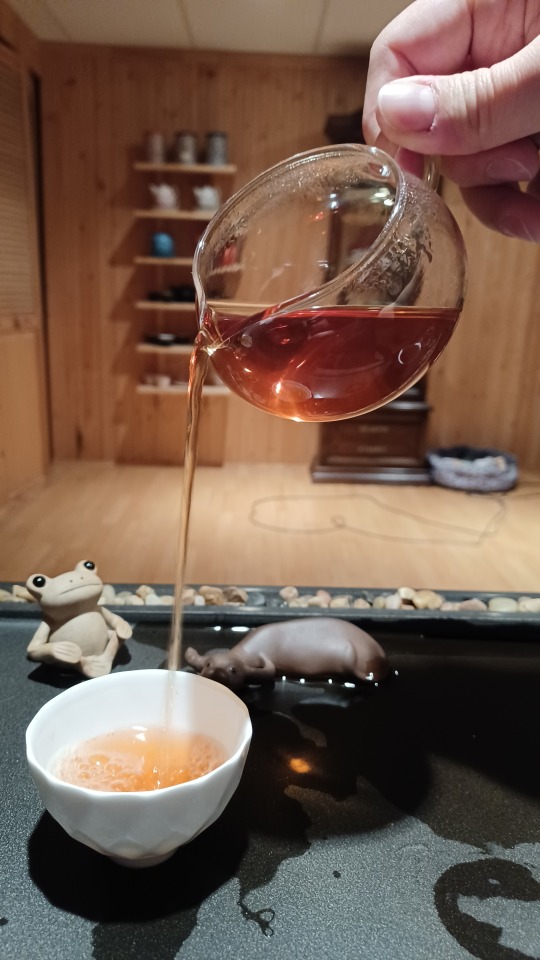
Admittedly this was my first experience with an unsmoked Lapsang. It’s no doubt an enjoyable tea that is perfect for the cold wintery season. To me, the tea didn’t quite have any kind of a WOW factor, but I did very much enjoy a tea with a natural spiciness as opposed to a tea with spice added. Regardless, it’s a great tea for the daily black tea drinker to enjoy.
3 out of 5 stars.
#white2tea#lapsang#lapsangsouchong#tea#teablr#black#blacktea#loosetea#spice#spiced#cinnamon#nutmeg#smoked#smokey
3 notes
·
View notes
Photo
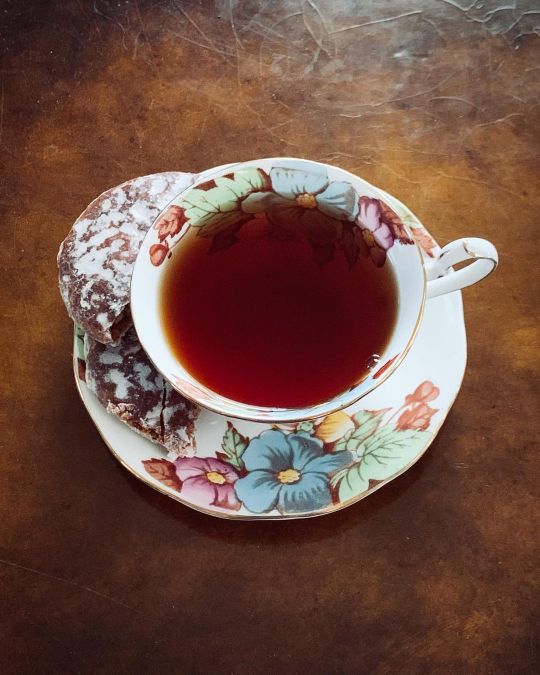
Spiced and smoked black tea with a side of Lebkuchen. It was just the thing for a day of heavy skies. 🫖 #tea #teatime #timefortea #teacup #teacupsofinstagram #vintageteacups #lebkuchen #spicedtea #blacktea #lapsangsouchong #teaandcookies #teaandbiscuits #cuppa #cuppatea (at Bellingham, Washington) https://www.instagram.com/p/CHqdfrjAfM7/?igshid=14lwnmdgp5nbs
#tea#teatime#timefortea#teacup#teacupsofinstagram#vintageteacups#lebkuchen#spicedtea#blacktea#lapsangsouchong#teaandcookies#teaandbiscuits#cuppa#cuppatea
72 notes
·
View notes
Text
Me as I drink a hot cup of lapsangsouchong:
* S m o k e y B r e a t h *
I am a dragon now
(For those who don’t know, lapsangsouchong is a black tea that has been smoked over wood, usually pinewood. )
Also If you plan to try it steep at a relatively lower temp. It can be very pungent if steeped in water right off the stove top.
1 note
·
View note
Text
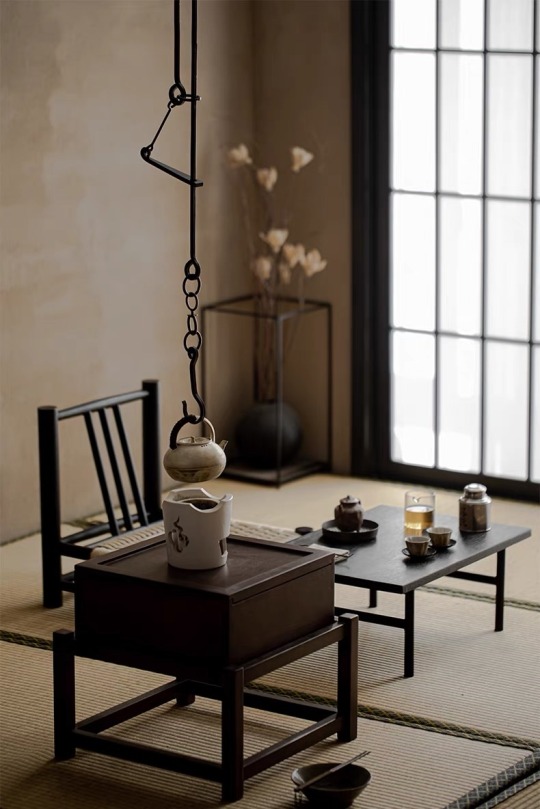

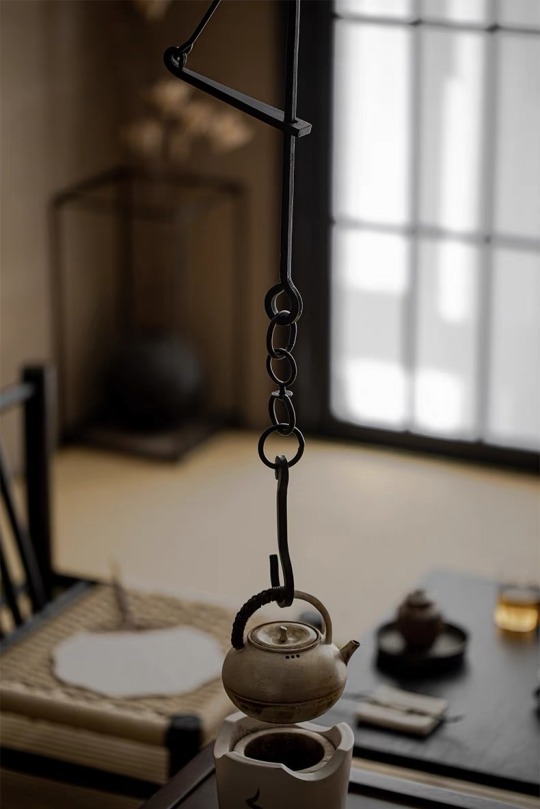


Having a full pantry can be fun and reassuring.
#tea room#corner#iron art#expression#morimatea#teapot#teacup#chaxi#teaceremony#teatray#tea#teatime#beautiful#simplicity#lapsangsouchong#lifestyle
1 note
·
View note
Text
Exploring the World of Black Teas: A Comprehensive Guide

Black tea, with its bold flavors, rich history, and countless varieties, holds a special place in the hearts of tea lovers worldwide. Whether you’re sipping a robust morning brew or enjoying a delicate afternoon cup, black tea offers an experience that’s both comforting and invigorating. In this 1000-word blog post, we’ll dive into everything you need to know about black teas—from what makes them unique to their health benefits, brewing tips, and cultural significance. By the end, you’ll be inspired to explore this timeless beverage and perhaps discover a new favorite blend.
What is Black Tea?
Black tea is a fully oxidized tea made from the leaves of the Camellia sinensis plant. This oxidation process—where the leaves are exposed to air, turning them dark and intensifying their flavor—distinguishes black tea from other varieties like green, white, or oolong, which undergo minimal or partial oxidation. The result is a tea that’s deep in color, robust in taste, and often described as malty, earthy, or subtly sweet.
Black tea serves as the foundation for many beloved blends, such as Earl Grey, chai, and English Breakfast. Its flavor can vary widely depending on where it’s grown, how it’s processed, and whether it’s blended with spices, herbs, or citrus notes. This versatility makes black tea a staple in households and tea shops around the globe.
The Origins of Black Tea
The story of black tea begins in China during the Ming Dynasty (1368–1644). According to legend, a batch of green tea leaves was left to oxidize by mistake, giving birth to the darker, bolder black tea we know today. This happy accident quickly caught on, and black tea became a prized commodity.
By the 17th century, black tea had reached Europe, where it captured the British imagination. The British passion for tea spurred the growth of plantations in India and Sri Lanka (then Ceylon), transforming black tea into a global phenomenon. Today, these regions—along with China—remain leading producers, each contributing unique flavors shaped by their local climate and soil.
Types of Black Tea
Black tea comes in a dazzling array of varieties, each with its own personality. Here are some of the most popular types:
Assam: Grown in India’s Assam region, this tea is bold and malty, with a bright, reddish hue. It’s a go-to for breakfast blends thanks to its high caffeine kick.
Darjeeling: Known as the “Champagne of Teas,” Darjeeling hails from India’s Himalayan foothills. It’s lighter and more delicate, with floral and fruity undertones.
Ceylon: From Sri Lanka, Ceylon tea offers a crisp, citrusy taste that shines on its own or in flavored blends like Earl Grey.
Keemun: A Chinese classic, Keemun is smooth and slightly smoky, with a wine-like sweetness that makes it a favorite in traditional blends.
Lapsang Souchong: Also from China, this tea stands out with its smoky flavor, achieved by drying the leaves over pinewood fires.
For those who love a powerful brew, discover the strongest black tea at Backyard Brew. Their expertly crafted blends deliver an intense, satisfying punch, perfect for tea enthusiasts seeking a bold experience.
Brewing the Perfect Cup of Black Tea
Brewing black tea is simple yet rewarding when done right. Follow these steps to unlock its full potential:
Water Temperature: Heat water to 200–212°F (93–100°C). Near-boiling water extracts the tea’s rich flavors effectively.
Tea Quantity: Use 1 teaspoon of loose leaf tea per 8 ounces of water. Adjust this amount for a stronger or milder cup.
Steeping Time: Let the tea steep for 3–5 minutes. Too long, and it may turn bitter; too short, and it might lack depth.
Optional Add-Ins: Enhance your tea with milk, sugar, honey, or a slice of lemon. Experiment to find your ideal mix.
For the best results, use fresh, filtered water and avoid reboiling, as this can dull the tea’s taste. With a little practice, you’ll brew a cup that’s perfectly tailored to your palate.
Health Benefits of Black Tea
Beyond its delightful taste, black tea offers a range of health perks. Here’s why you might want to make it a daily habit:
Antioxidant Powerhouse: Black tea is loaded with polyphenols, which combat cell damage and may lower the risk of chronic illnesses.
Heart Health: Research suggests that drinking black tea regularly could reduce blood pressure and support cardiovascular wellness.
Mental Boost: With a moderate caffeine dose (40–70 mg per cup) and L-theanine, black tea sharpens focus without the jittery side effects of coffee.
Digestive Support: It can soothe an upset stomach and promote healthy digestion.
Weight Management: Some studies indicate that black tea may boost metabolism, aiding weight loss efforts when paired with a balanced lifestyle.
While black tea is safe for most, its caffeine content means moderation is key—especially if you’re sensitive to stimulants.
The Cultural Significance of Black Tea
Black tea isn’t just a drink; it’s a cultural icon. In Britain, it anchors the tradition of afternoon tea, a ritual born in the 19th century. In India, chai—a spiced black tea with milk and sugar—is a daily comfort. In China, serving black tea is a gesture of warmth and hospitality.
Historically, black tea has even shaped world events. The Boston Tea Party of 1773, a protest against tea taxes, helped spark the American Revolution. Today, black tea remains a symbol of connection, enjoyed in homes, cafes, and ceremonies worldwide.
Conclusion
Black tea is a beverage that transcends time and borders, offering a blend of flavor, history, and wellness in every sip. From its accidental origins in China to its starring role in cultures across the globe, black tea has earned its status as a beloved classic. Whether you’re drawn to the robustness of Assam, the elegance of Darjeeling, or the smokiness of Lapsang Souchong, there’s a black tea for every mood and moment. So, brew a pot, savor the aroma, and let black tea become a cherished part of your day.
FAQs About Black Tea
1. How is black tea different from other teas?
Black tea is fully oxidized, giving it a darker color and stronger flavor compared to green, white, or oolong teas, which are less processed.
2. What is the caffeine content in black tea?
A typical 8-ounce cup contains 40–70 mg of caffeine—about half as much as coffee—depending on the type and brewing time.
3. Can black tea help with weight loss?
It’s not a cure-all, but black tea may support weight loss by boosting metabolism and curbing appetite when combined with healthy habits.
4. How should I store black tea?
Store it in an airtight container, away from light, heat, and moisture, to keep its flavor and freshness intact.
5. Is black tea good for your skin?
Yes, its antioxidants can protect skin from damage and may help reduce signs of aging with regular consumption.
#BlackTea#TeaLovers#HealthBenefits#BlackTeaBlends#AssamTea#DarjeelingTea#CeylonTea#KeemunTea#LapsangSouchong#TeaCulture#BrewingTea#TeaTraditions#WeightLossTea#Antioxidants#TeaRituals#CaffeineBoost#BlackTeaRecipes#TeaTime#TeaAddict#LooseLeafTea#TeaBrewing
1 note
·
View note
Text
You make one tiny engagement with TERF discourse on Twitter and they just flood your mentions with their bad faith and passive-aggression
Anyway, look at this cake I made, it tastes of tea!!!!
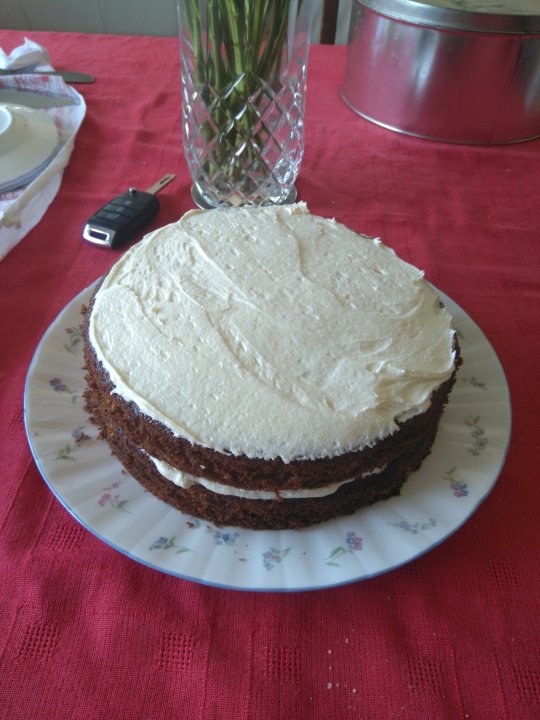
2 notes
·
View notes
Photo

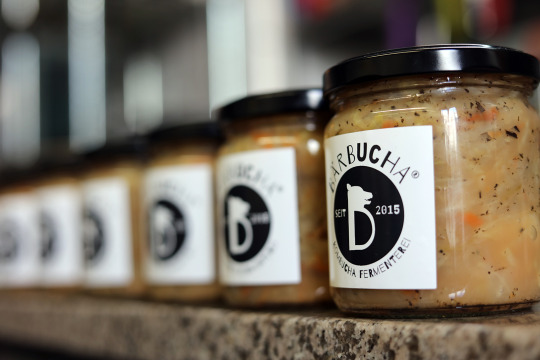
Smoked Sauerkraut aka Sauerkraut fermented with Lapsang Souchong tea (famous Chinese smoked tea). Yum!
#bärbuchafermenterei#cafebärbucha#kombuchacafeberlin#fermentedinberlin#lactofermented#sauerkraut#lapsangsouchong
3 notes
·
View notes
Photo


© Peter Arkle 10-2020
4 notes
·
View notes